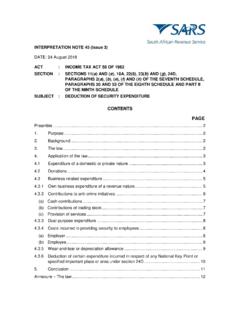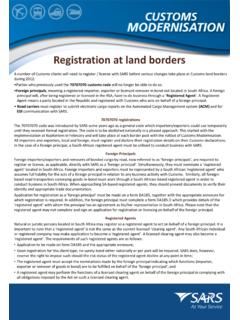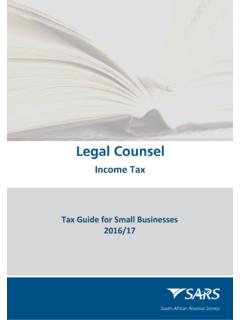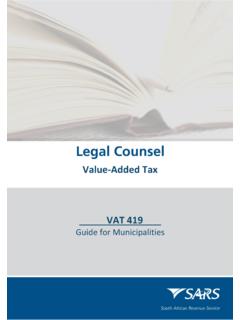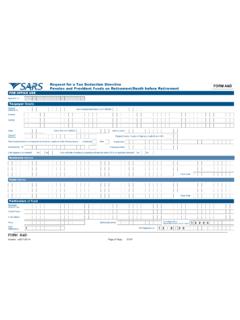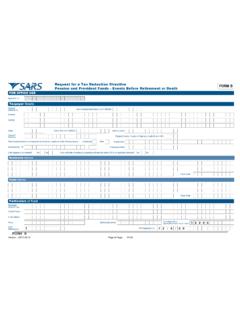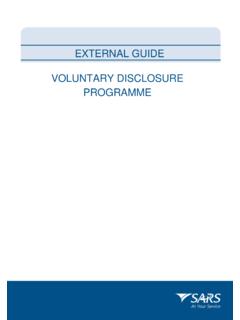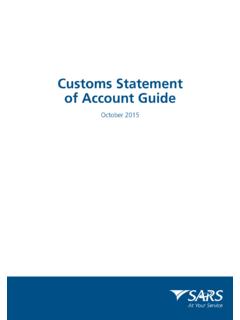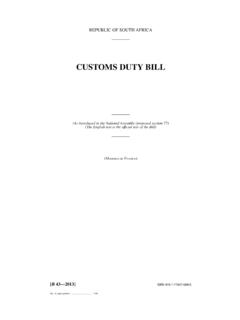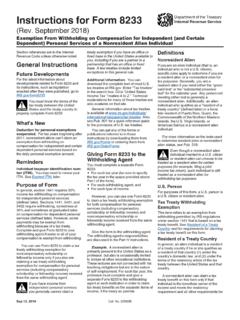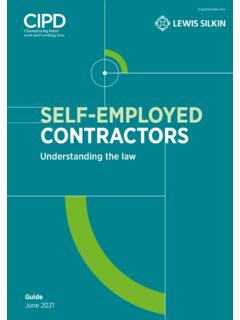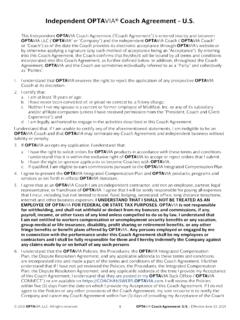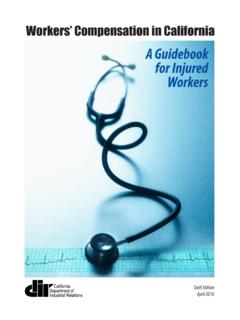Transcription of INTERPRETATION NOTE 17 (Issue 5) ACT : INCOME TAX ACT …
1 INTERPRETATION NOTE 17 (Issue 5) DATE: 5 March 2019 ACT : INCOME TAX ACT 58 OF 1962 SECTION : THE FOURTH SCHEDULE SUBJECT : EMPLOYEES TAX: independent CONTRACTORS CONTENTS PAGE Preamble .. 2 1. Purpose .. 2 2. Background .. 3 3. INTERPRETATION of the Fourth Schedule .. 4 Paragraph (ii) of the special exclusions from the definition of remuneration .. 4 Labour Brokers [paragraph 2(5) of the Fourth Schedule] .. 6 4. When is it required of SARS to determine the status of a person? .. 6 5. The statutory tests .. 7 The first 7 The second test .. 8 6. The common law dominant impression test .. 9 7. How to apply the common law dominant impression test .. 9 8. The common law dominant impression indicators (the indicators) .. 10 Near-conclusive indicators of the acquisition of productive capacity (of employee status or non- independent business status) .. 10 Control of manner.
2 10 Payment regime .. 11 Person who must render the service .. 12 Nature of obligation to work .. 12 Employer (client) base .. 12 Risk, profit and loss .. 13 Persuasive indicators of the acquisition of productive capacity (of employee status or non- independent business status) .. 13 Instructions or supervision .. 13 Reports .. 14 Training .. 14 2 Productive time (control of working hours, the working week) .. 15 Indicators resonant (creating an immediate or superficial impression of) of an employee relationship or an independent contractor 16 Tools, materials, stationery etc .. 16 Office or 16 Integration or employer s usual work premises .. 16 Integration or usual business operations .. 16 Integration or hierarchy and organogram .. 16 Duration of relationship .. 17 Termination and breach of contract .. 17 Significant investment.
3 17 Bona fide business expenses, bona fide statutory compliance .. 17 (a) Stereo-typical labels .. 17 (b) Stereo-typical clauses and statutory compliance .. 18 (c) Stereo-typical expenses .. 18 Viability on termination .. 18 Industry norms and custom .. 19 9. Summary .. 19 Annexure A The law .. 20 Annexure B Flow 21 Annexure C Common law dominant impression test grid .. 22 Annexure D The concept of independent contractor at common law .. 23 Annexure E The current common law position in South Africa .. 25 Preamble In this Note unless the context indicates otherwise paragraph means a paragraph of the Fourth Schedule to the Act; section means a section of the Act; the Act means the INCOME Tax Act 58 of 1962; and any other word or expression bears the meaning ascribed to it in the Act. All binding general rulings, forms, guides and INTERPRETATION notes referred to in this Note are available on the SARS website at Unless indicated otherwise, the latest issues of these documents should be consulted.
4 1. Purpose This Note explains the statutory tests and the common law tests to assist SARS officials and employers to classify a worker efficiently and effectively. This Note has been updated to incorporate the latest amendments made under section 5(1)(d) of the Tax Administration Laws Amendment Act 16 of 2016, effective from 1 March 2017, to the exclusionary subparagraph (ii) of the definition of remuneration as defined in paragraph 1. 3 Binding General Ruling 40 Remuneration Paid to Non-Executive Directors and the Non-Executive Directors FAQs on BGRs 40 and 41 address the independent contractor status of non-executive directors. This Note therefore does not apply to non-executive directors. 2. Background The concept of an independent trader or independent contractor (synonymous for practical purposes) still remains one of the more contentious features of the Fourth Schedule.
5 A decision in favour of either independent contractor or employee status impacts on an employer s liability to deduct employees tax. The liability of an employer to deduct employees tax is dependent on whether remuneration as defined in paragraph 1 is paid. Subject to certain conditions, amounts paid to an independent contractor for services rendered are excluded from remuneration as defined, in which case an employer has no obligation to deduct employees tax from the amounts paid. Two sets of tools are available to determine whether a person is an independent contractor for employees tax purposes. The first tool is referred to as the statutory tests. There are two statutory tests, and they are both conclusive in nature. If the first test is met, the person is deemed not to be carrying on a trade independently, with the result that the amount paid is deemed to be remuneration and will be subject to employees tax, unless the second test is met.
6 In the event that the second test is satisfied, the person will be deemed to be carrying on a trade independently, and the amount earned will not be remuneration as defined and will consequently not be subject to employees tax. It is possible that a person could meet the first test, and be deemed not to be carrying on an independent trade, but meet the second test and then be deemed to be carrying on an independent trade. The second test overrides the first test. The second tool is the common law tests, used to determine whether a person is an independent contractor or an employee. Unfortunately, the common law tests as they apply in South Africa do not permit a simple checklist approach. There are no hard and fast rules in determining whether a person is an independent contractor. An overall or dominant impression of the employment relationship must be formed.
7 In practice, the statutory tests are considered first. The common law tests are applied to finally determine whether the person is an independent contractor or an employee only if the statutory tests are not applicable in a particular situation. This Note includes the INTERPRETATION of the relevant legislation, an explanation of the statutory tests, an explanation of the common law tests as captured in the dominant impression test, a flow diagram explaining the structure of the legislation, the dominant impression test grid for quick reference and a historical overview of the common law principles. This Note is not intended to be exhaustive of all scenarios which may occur in practice, and may not deal with certain issues based on specific facts. It must be accepted that this Note will be revised periodically in the light of public debate, court judgements and legislative reform.
8 4 The common law history (Annexure D) provides a more in-depth analysis of the concept by making reference to Latin and legal terms often used by lawyers and tax consultants. The flow diagram (Annexure B) and the dominant impression grid (Annexure C) provide a useful summary and quick reference guide of the detailed content. 3. INTERPRETATION of the Fourth Schedule The Fourth Schedule requires the presence of three elements before employees tax can be levied, namely, an employer paying remuneration to an employee (Annexure A). The determination of whether an independent trade is being carried on must be made in two instances under the Fourth Schedule, namely in exclusionary subparagraph (ii) of the definition of remuneration ; and paragraph 2(5)(a)(i), it is necessary to decide whether a labour broker qualifies for an employees tax exemption certificate.
9 Paragraph (ii) of the special exclusions from the definition of remuneration Amounts (that would otherwise be remuneration) paid to a person as contemplated in paragraph (a) of the definition of an employee in the Fourth Schedule are excluded from the definition of remuneration if that person carries on an independent trade. Also excluded are persons who are not resident in South Africa. The exclusion would therefore in general only be applicable to natural persons or trusts (who are not personal service providers) that are resident in South Africa. The exclusion does not apply to payments made to the following categories of employees as defined: 1. Any person who receives remuneration by reason of services rendered to a labour broker [paragraph (b) of the definition of employee ]; 2. Any labour broker [paragraph (c) of the definition]; 3.
10 Any persons declared by the Minister of Finance in the Government Gazette that they are employees [paragraph (d)]; and 4. Any personal service provider [paragraph (e)]. The law governing the test to determine whether a person carries on an independent trade under the common law is complex, is commonly misunderstood, and is often incorrectly applied. The relevant legislation is set out in paragraph (ii) of the special exclusions from the definition of remuneration. To simplify the discussion of this part of the law, the wording is set out below. Remuneration as defined excludes any amount paid or payable in respect of services rendered or to be rendered by any person .. in the course of any trade carried on by him independently of the person by whom such amount is paid or payable and of the person to whom such services have been or are to be rendered: (Emphasis added.)
